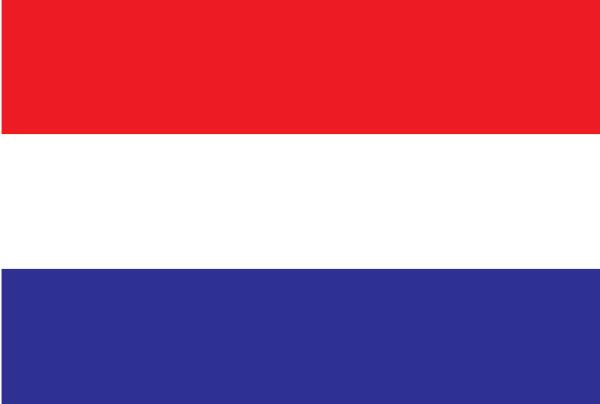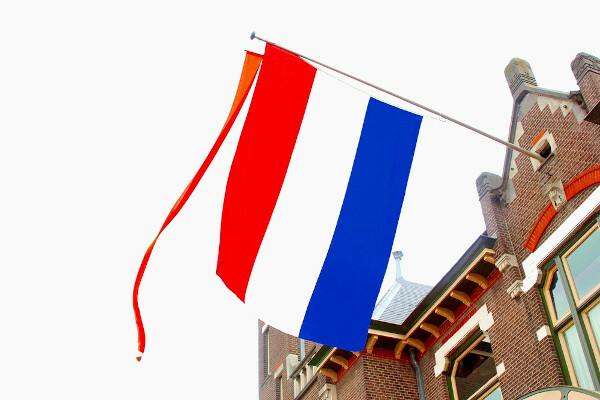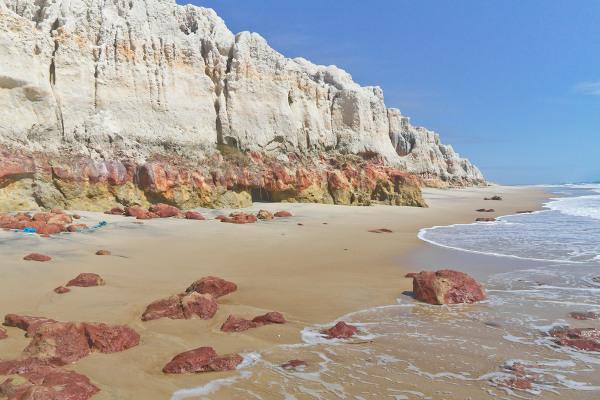A flag of Holland (Netherlands) it is a symbol of the country, and represents its history and independence. Initially in the colors orange, white and blue, the origin of the Dutch flag is associated with William I, Prince of Orange, who led the fight for the country's independence in the 16th century. Over the years, the color orange was gradually changed, and red was made official as one of the colors of flag of the Netherlands at the end of the 1930s, remembering that the Netherlands officially adopted the name Netherlands in 2020.
Read too: Flag of Germany — a flag representing unity, freedom and democracy
Topics of this article
- 1 - Summary about the flag of Holland (Netherlands)
-
2 - Meaning of the Netherlands flag
- → Meaning of the colors of the Netherlands flag
- 3 - History of the flag of the Netherlands
- 4 - Main characteristics of Holland (Netherlands)
- 5 - Curiosities about the flag of Holland
Abstract about flag of Netherlands (Netherlands)
The flag of Holland (Netherlands) is formed by three horizontal stripes of the same thickness in vibrant red, white and cobalt blue colors.
There is no symbol stamped on the Dutch flag.
It represents freedom and independence.
Its colors are associated with William I, Prince of Orange, who led the Netherlands' independence movement from Spain.
It has inspired other European flags such as the flag of France.
The Dutch flag was initially composed of the colors orange, white and blue. Over time, red came to be used in place of orange.
The colors of the flag of the Netherlands were made official by the Dutch Crown in 1937.
Do not stop now... There's more after the publicity ;)
Netherlands flag meaning
The flag of Holland (now officially the Netherlands) is one of the symbols that representsm the country. Rectangular in shape, it is made up of three horizontal bands of the same thickness in red, white and blue. Initially adopted in the 16th century, albeit with orange in place of red, the flag of the Netherlands represents the fight for the country's independence and freedom.
→ Netherlands flag colors meaning

The colors red, white and blue are present in the Dutch flag, and are associated with the Prince of Orange William I. They are present in several other European flags, mainly, and it is believed that some of them have sought inspiration in the history of the flag of the Netherlands for their adoption.
While there isn't an official meaning for each of the colors individually, there are some interpretations to explain them.
Red: makes up the top band of the Dutch flag. It is the most recent color to be introduced, considering that the initial orange was being changed until reaching the vibrant red tone, as it is officially described. Red is believed to represent strength and bravery.
White: makes up the central band of the flag of the Netherlands. Traditionally, this is the color that represents peace.
Blue: makes up the lower band of the flag, and is officially described as cobalt blue. It represents justice and perseverance.
Dutch flag history
The flag of the Netherlands dates back to the Eighty Years' War, a dispute that lasted from 1568 to 1648 and that can be described as the Dutch struggle for independence from theSpain. One of the main names in this conflict was William I, Prince of Orange, to whom the composition of the country's flag is attributed.
The coat of arms used by the Prince of Orange had the colors orange, white and blue, which were adopted by soldiers and fleets of ships to indicate their origin. Orange, however, has been changed over the years, with its hue changing from orange tones to red.
For a while, both colors were used on flags, which changed definitively from the 1930s onwards. Through a royal decree dated 1937, the red, white and blue were made official. like the colors of the flag of the Netherlands.
See too: Flag of Ghana — another flag related to the independence of a country
Main characteristics of Holland (Netherlands)
Holland is a country located in the region of Europe western, where it borders the Belgium and the Germany. In addition to its continental European territory, it has six overseas territories in the Lesser Antilles region, in Central America.
Bathed by the North Sea, the Dutch territory has temperate climate oceanic with winters cold and summers mild and rains recurring throughout the year. Its vegetation cover consists of several species typical of flooded areas., such as marshes, in addition to woods and fields. The relief of the Netherlands is formed essentially by plains, with an average elevation of only 30 meters of altitude.

The Dutch population is currently 17.1 million inhabitants, which form a densely populated territory whose population distribution is around 509 inhab./km². The city of Amsterdam, the capital of the country, consists of its largest urban center, with more than 1 million inhabitants. Overall, more than 90% of people live in cities in the Netherlands.
The Dutch economy stands out for its high degree of development and modernization, still being one of the largest European Union, economic bloc of which it is a part. A industry and commerce are the two main branches of the economy of the Netherlands, being also a reference when it comes to transport. According to the HDI, currently 0.941, the country can still be considered the 10º country the world in terms of development and quality of life.
It is important to point out that the Netherlands officially changed its name to Netherlands in 2020. Today the denomination Holland composes the name of two provinces of the country: North Holland and South Holland.
Facts about the Netherlands flag

The Netherlands flag is considered to be the oldest tricolor flag in the world in terms of usage.
A France flag, adopted during the French Revolution, is inspired by the flag of the Netherlands. The red-white-blue tricolor scheme was understood by the French as a symbol of freedom.
The other countries belonging to the Kingdom of the Netherlands, such as Aruba, Curacao and Sint Maarten, have their own flags.
On important celebrations of the Royal Family, such as birthdays and King's Day, the addition of from a pendant with a narrow orange band to the flagpole, thus representing the House of Orange.
The color sequence of the Netherlands flag is the same as that of Luxembourg. What sets them apart is the shade of blue, lighter than the Luxembourg flag, and the width of the rectangle.
By Paloma Guitarrara
Geography Teacher
Would you like to reference this text in a school or academic work? Look:
GUITARRA, Paloma. "Flag of Netherlands (Netherlands)"; Brazil School. Available in: https://brasilescola.uol.com.br/geografia/bandeira-da-holanda-paises-baixos.htm. Accessed on April 07, 2023.
Read our text about the flag of France and understand the meaning of this important national symbol. Discover how the flag was created and some curiosities.
Click here to access a set of maps of Europe and deepen your knowledge of the continent. Also read some curiosities about this region.
Have you heard of the Netherlands? Click here, study the main aspects of the geography of this European country and also learn about its economy, history and culture.
Find out which countries are in Europe. See the list of countries on the European continent and the regions in which they are located. Also find out what the European Union is.


